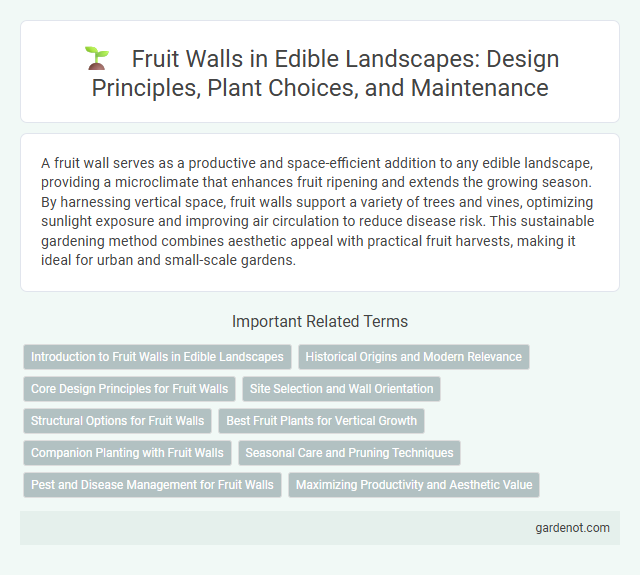A fruit wall serves as a productive and space-efficient addition to any edible landscape, providing a microclimate that enhances fruit ripening and extends the growing season. By harnessing vertical space, fruit walls support a variety of trees and vines, optimizing sunlight exposure and improving air circulation to reduce disease risk. This sustainable gardening method combines aesthetic appeal with practical fruit harvests, making it ideal for urban and small-scale gardens.
Introduction to Fruit Walls in Edible Landscapes
Fruit walls are an innovative feature in edible landscapes that maximize space by training fruit-bearing plants vertically on walls or fences. These walls create microclimates, enhancing sunlight exposure and warmth, which improves fruit yield and quality in limited garden areas. Incorporating fruit walls supports sustainable gardening by producing fresh, homegrown produce while adding aesthetic and functional value to outdoor spaces.
Historical Origins and Modern Relevance
Fruit walls originated in medieval Europe as practical structures to protect delicate fruit trees from harsh climates and maximize sun exposure for optimal growth. These walls improved microclimates, allowing for extended growing seasons and higher yields of apples, pears, and peaches. Today, fruit walls are valued in edible landscapes for their sustainability, aesthetic appeal, and ability to support diverse, high-quality fruit production in urban and small-scale gardens.
Core Design Principles for Fruit Walls
Fruit walls maximize microclimate benefits by capturing and retaining heat, which promotes early fruit ripening and extended growing seasons. Structural integrity relies on using durable materials like brick or stone to support espaliered fruit trees, ensuring both stability and optimal sunlight exposure. Proper spacing and pruning techniques enhance air circulation and light penetration, reducing disease risk and improving fruit quality.
Site Selection and Wall Orientation
Selecting a site with ample sunlight exposure is crucial for a fruit wall to maximize photosynthesis and fruit production. South-facing walls are preferred in the Northern Hemisphere for optimal heat retention and light capture, while north-facing orientations are ideal in the Southern Hemisphere. Proper site selection also considers wind protection and soil quality to enhance growth and fruit yield on the edible landscape.
Structural Options for Fruit Walls
Fruit walls can be constructed using timber, brick, or stone materials, each providing specific thermal benefits essential for wall-trained fruit trees. Timber fruit walls offer a lightweight, flexible structure ideal for espalier or fan-trained trees, while brick and stone walls retain heat during the day and release it at night, extending growing seasons. Incorporating trellises or wire frameworks onto these walls enhances fruit support and maximizes sun exposure.
Best Fruit Plants for Vertical Growth
Fruit walls maximize limited garden space by supporting vertical growth of fruit plants like espalier apples, climbing raspberries, and kiwifruit. Espalier apples thrive when trained against south-facing walls, benefiting from reflected heat to enhance fruit ripening. Climbing raspberries and kiwifruit use trellises to optimize sunlight exposure and air circulation, promoting higher yields and easier harvesting.
Companion Planting with Fruit Walls
Fruit walls maximize microclimates by absorbing heat and extending growing seasons, creating ideal conditions for companion planting. Strategic placement of herbs, flowers, and nitrogen-fixing plants like comfrey or clover alongside fruit trees on these walls enhances pest control, improves soil fertility, and boosts fruit production. This synergistic planting increases biodiversity, reduces the need for chemical inputs, and supports a resilient edible landscape.
Seasonal Care and Pruning Techniques
Fruit walls require seasonal care to maximize fruit production and plant health. During late winter, dormant pruning encourages new growth by removing dead or overcrowded branches, improving air circulation and sunlight exposure. Summer pruning shapes the fruit wall and controls vigorous shoots, ensuring optimal fruit development and reducing disease risk.
Pest and Disease Management for Fruit Walls
Effective pest and disease management is crucial for maintaining healthy fruit walls, ensuring optimal fruit production and longevity. Integrated pest management (IPM) techniques, including regular monitoring, biological controls such as beneficial insects, and targeted use of organic pesticides, reduce the incidence of common fruit wall pests like aphids, codling moths, and scale insects. Disease prevention involves proper pruning to enhance air circulation, choosing disease-resistant varieties, and applying fungicidal treatments to control issues like powdery mildew and fire blight.
Maximizing Productivity and Aesthetic Value
A fruit wall enhances edible landscapes by maximizing productivity through efficient use of vertical space, supporting high-yield fruit varieties like espaliered apples and pears. It creates microclimates that extend growing seasons and protect plants from wind, increasing fruit quality and harvest. The structured design also adds aesthetic value, blending functional gardening with architectural beauty in outdoor spaces.
Fruit wall Infographic

 gardenot.com
gardenot.com